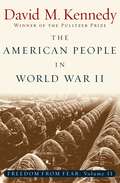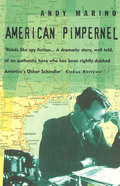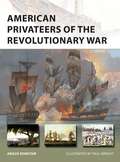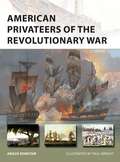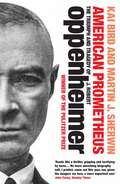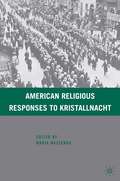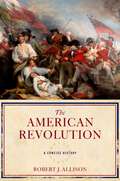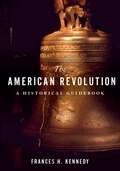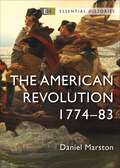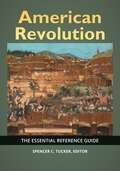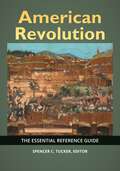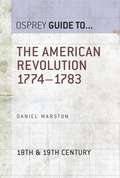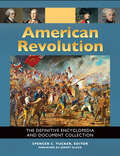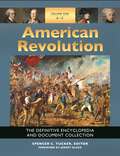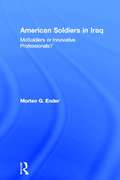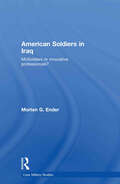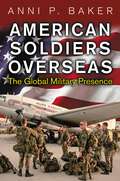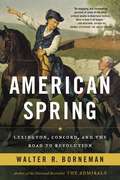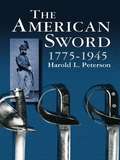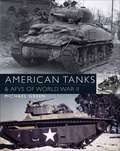- Table View
- List View
The American People in World War II: Freedom from Fear, Part Two (Oxford History of the United States)
by David M. KennedyEven as the New Deal was coping with the Depression, a new menace was developing abroad. Exploiting Germany's own economic burdens, Hitler reached out to the disaffected, turning their aimless discontent into loyal support for his Nazi Party. In Asia, Japan harbored imperial ambitions of its own. The same generation of Americans who battled the Depression eventually had to shoulder arms in another conflict that wreaked worldwide destruction, ushered in the nuclear age, and forever changed their way of life and their country's relationship to the rest of the world. The American People in World War II--the second installment of Kennedy's Pulitzer Prize-winning Freedom from Fear--explains how the nation agonized over its role in the conflict, how it fought the war, why the United States emerged victorious, and why the consequences of victory were sometimes sweet, sometimes ironic. In a compelling narrative, Kennedy analyzes the determinants of American strategy, the painful choices faced by commanders and statesmen, and the agonies inflicted on the millions of ordinary Americans who were compelled to swallow their fears and face battle as best they could. The American People in World War II is a gripping narrative and an invaluable analysis of the trials and victories through which modern America was formed.
American Pimpernel: The Man Who Saved the Artists on Hitler's Death-List
by Andy MarinoThe incredible story of the American who saved more lives than Schindler - great literary, scientific and artistic figures such as André Breton, Heinrich Mann, Marc Chagall and Max Ernst who represented the political and cultural elite of Europe. This is one of the last great untold stories of World War II.Varian Fry was an outsider, a flawed man who was transformed by the advent of war in Europe, finding his purpose as the saviour of hundreds of people facing death under the Nazis. Marino traces the progress of a seemingly impossible rescue operation, revealing the charismatic personality of Fry, and tells the story of those who helped him. It is a tale full of surreal and heart-stopping episodes: a novelist smuggled out of a concentration camp right under the noses of the guards; and the 'secret' escape route up a mountainside in full view of the entire population of Cerbère.This is the first time his full, true story has been told, with the benefit of the author's access to archives and the cooperation of those who best knew Varian Fry.
American Privateers of the Revolutionary War (New Vanguard #279)
by Angus KonstamDuring the American War of Independence (1775–83), Congress issued almost 800 letters of marque, as a way of combating Britain's overwhelming naval and mercantile superiority. At first, it was only fishermen and the skippers of small merchant ships who turned to privateering, with mixed results. Eventually though, American shipyards began to turn out specially-converted ships, while later still, the first purpose-built privateers entered the fray. These American privateers seized more than 600 British merchant ships over the course of the war, capturing thousands of British seamen. Indeed, Jeremiah O'Brien's privateer Unity fought the first sea engagement of the Revolutionary War in the Battle of Machias of 1775, managing to capture a British armed schooner with just 40 men, their guns, axes and pitchforks, and the words 'Surrender to America'. By the end of the war, some of the largest American privateers could venture as far as the British Isles, and were more powerful than most contemporary warships in the fledgling US Navy. A small number of Loyalist privateers also put to sea during the war, and preyed on the shipping of their rebel countrymen. Packed with fascinating insights into the age of privateers, this book traces the development of these remarkable ships, and explains how they made such a significant contribution to the American Revolutionary War.
American Privateers of the Revolutionary War (New Vanguard #279)
by Angus KonstamDuring the American War of Independence (1775–83), Congress issued almost 800 letters of marque, as a way of combating Britain's overwhelming naval and mercantile superiority. At first, it was only fishermen and the skippers of small merchant ships who turned to privateering, with mixed results. Eventually though, American shipyards began to turn out specially-converted ships, while later still, the first purpose-built privateers entered the fray. These American privateers seized more than 600 British merchant ships over the course of the war, capturing thousands of British seamen. Indeed, Jeremiah O'Brien's privateer Unity fought the first sea engagement of the Revolutionary War in the Battle of Machias of 1775, managing to capture a British armed schooner with just 40 men, their guns, axes and pitchforks, and the words 'Surrender to America'. By the end of the war, some of the largest American privateers could venture as far as the British Isles, and were more powerful than most contemporary warships in the fledgling US Navy. A small number of Loyalist privateers also put to sea during the war, and preyed on the shipping of their rebel countrymen. Packed with fascinating insights into the age of privateers, this book traces the development of these remarkable ships, and explains how they made such a significant contribution to the American Revolutionary War.
American Prometheus: The Triumph and Tragedy of J. Robert Oppenheimer
by Kai Bird Martin J. Sherwin***SOON TO BE A MAJOR HOLLYWOOD FILM DIRECTED BY CHRISTOPHER NOLAN***WINNER OF THE PULITZER PRIZE FOR NONFICTION 'Reads like a thriller, gripping and terrifying' Sunday TimesPhysicist and polymath, as familiar with Hindu scriptures as he was with quantum mechanics, J. Robert Oppenheimer - director of the Manhattan Project that developed the atomic bomb - was the most famous scientist of his generation. In their meticulous and riveting biography, Kai Bird and Martin J. Sherwin reveal a brilliant, ambitious, complex and flawed man, profoundly involved with some of the momentous events of the twentieth century.
American Religious Responses to Kristallnacht
by M. MazzengaThis book examines how American Protestants, Catholics and Jews responded to the persecution of Jews in Germany and German-occupied territory in the 1930s. The essays focus on American religious responses to Kristallnacht and represent the first examination of multi-religious group responses to the beginnings of the Holocaust.
The American Revolution: A Concise History
by Robert AllisonHere is a brisk, accessible, and vivid introduction to arguably the most important event in the history of the United States--the American Revolution. Between 1760 and 1800, the American people cast off British rule to create a new nation and a radically new form of government based on the idea that people have the right to govern themselves. In this lively account, Robert Allison provides a cohesive synthesis of the military, diplomatic, political, social, and intellectual aspects of the Revolution, paying special attention to the Revolution's causes and consequences. The book recreates the tumultuous events of the 1760s and 1770s that led to revolution, such as the Boston Massacre and the Boston Tea Party, as well as the role the Sons of Liberty played in turning resistance into full-scale revolt. Allison explains how and why Americans changed their ideas of government and society so profoundly in these years and how the War for Independence was fought and won. He highlights the major battles and commanders on both sides--with a particular focus on George Washington and the extraordinary strategies he developed to defeat Britain's superior forces--as well as the impact of French military support on the American cause. In the final chapter, Allison explores the aftermath of the American Revolution: how the newly independent states created governments based on the principles for which they had fought, and how those principles challenged their own institutions, such as slavery, in the new republic. He considers as well the Revolution's legacy, the many ways its essential ideals influenced other struggles against oppressive power or colonial systems in France, Latin America, and Asia. Sharply written and highly readable, The American Revolution offers the perfect introduction to this seminal event in American history.
The American Revolution: A Concise History
by Robert AllisonHere is a brisk, accessible, and vivid introduction to arguably the most important event in the history of the United States--the American Revolution. Between 1760 and 1800, the American people cast off British rule to create a new nation and a radically new form of government based on the idea that people have the right to govern themselves. In this lively account, Robert Allison provides a cohesive synthesis of the military, diplomatic, political, social, and intellectual aspects of the Revolution, paying special attention to the Revolution's causes and consequences. The book recreates the tumultuous events of the 1760s and 1770s that led to revolution, such as the Boston Massacre and the Boston Tea Party, as well as the role the Sons of Liberty played in turning resistance into full-scale revolt. Allison explains how and why Americans changed their ideas of government and society so profoundly in these years and how the War for Independence was fought and won. He highlights the major battles and commanders on both sides--with a particular focus on George Washington and the extraordinary strategies he developed to defeat Britain's superior forces--as well as the impact of French military support on the American cause. In the final chapter, Allison explores the aftermath of the American Revolution: how the newly independent states created governments based on the principles for which they had fought, and how those principles challenged their own institutions, such as slavery, in the new republic. He considers as well the Revolution's legacy, the many ways its essential ideals influenced other struggles against oppressive power or colonial systems in France, Latin America, and Asia. Sharply written and highly readable, The American Revolution offers the perfect introduction to this seminal event in American history.
The American Revolution: A Historical Guidebook
by Frances H. KennedyIn 1996, Congress commissioned the National Park Service to compile a list of sites and landmarks connected with the American Revolution that it deemed vital to preserve for future generations. Some of these sites are well known--Bunker Hill, Valley Forge, Fort Ticonderoga--and in no danger of being lost; others less so-- Blackstock's Plantation in South Carolina or Bryan's Station in Kentucky--and more vulnerable. But all are central to the story of our nation's fight for independence. From battlefields to encampments, meeting houses to museums, these places offer us a chance to rediscover the remarkable men and women who founded this nation and to recognize the relevance of not just what they did, but where they did it. The American Revolution: A Historical Guidebook takes readers to nearly 150 of these sites, providing an overview of the Revolution through an exploration of the places where American independence was articulated, fought for, and eventually secured. Beginning with the Boston Common, first occupied by British troops in 1768, and closing with Fraunces Tavern in New York, where George Washington bid farewell to his officers on December 4, 1783, Kennedy takes readers on a tour of the most significant places of Revolutionary history. Accompanied by illuminating excerpts and essays from some of the foremost scholars in the field, including David McCullough, Barbara Tuchman, David Hackett Fischer, Eric Foner, and John Ferling, the entries move in a roughly chronological order from the pre-Revolutionary years up through 1787. Taken together, the combination of site, essay, and excerpt provides rich context and overview, giving a sense of the major figures and events as well as the course of the Revolution, and cover topics ranging from the Boston Tea Party to the frontier wars. The guide is encyclopedic in scope and covers a wide geographical sweep. Accompanied by historical maps, as well as a number of illuminating primary documents including the Declaration of Independence and letters from John Adams and George Washington, it offers a comprehensive picture of how the Revolutionary War unfolded on American soil, and also points readers to the best writing on the subject in the last fifty years. The American Revolution: A Historical Guidebook is an essential companion for anyone interested in the story and history of our nation's founding.
The American Revolution: A Historical Guidebook
by Frances H. KennedyIn 1996, Congress commissioned the National Park Service to compile a list of sites and landmarks connected with the American Revolution that it deemed vital to preserve for future generations. Some of these sites are well known--Bunker Hill, Valley Forge, Fort Ticonderoga--and in no danger of being lost; others less so-- Blackstock's Plantation in South Carolina or Bryan's Station in Kentucky--and more vulnerable. But all are central to the story of our nation's fight for independence. From battlefields to encampments, meeting houses to museums, these places offer us a chance to rediscover the remarkable men and women who founded this nation and to recognize the relevance of not just what they did, but where they did it. The American Revolution: A Historical Guidebook takes readers to nearly 150 of these sites, providing an overview of the Revolution through an exploration of the places where American independence was articulated, fought for, and eventually secured. Beginning with the Boston Common, first occupied by British troops in 1768, and closing with Fraunces Tavern in New York, where George Washington bid farewell to his officers on December 4, 1783, Kennedy takes readers on a tour of the most significant places of Revolutionary history. Accompanied by illuminating excerpts and essays from some of the foremost scholars in the field, including David McCullough, Barbara Tuchman, David Hackett Fischer, Eric Foner, and John Ferling, the entries move in a roughly chronological order from the pre-Revolutionary years up through 1787. Taken together, the combination of site, essay, and excerpt provides rich context and overview, giving a sense of the major figures and events as well as the course of the Revolution, and cover topics ranging from the Boston Tea Party to the frontier wars. The guide is encyclopedic in scope and covers a wide geographical sweep. Accompanied by historical maps, as well as a number of illuminating primary documents including the Declaration of Independence and letters from John Adams and George Washington, it offers a comprehensive picture of how the Revolutionary War unfolded on American soil, and also points readers to the best writing on the subject in the last fifty years. The American Revolution: A Historical Guidebook is an essential companion for anyone interested in the story and history of our nation's founding.
The American Revolution: 1774–83 (Essential Histories)
by Daniel MarstonUpdated and revised from the popular 2002 edition, with full-colour maps and new images throughout, this is a concise study of the American Revolutionary War. The American Revolution, or the American War of Independence, has been characterized politically as a united political uprising of the American colonies and militarily as a guerrilla campaign of colonists against the inflexible British military establishment. In this book, Daniel Marston argues that this belief, though widespread, is a misconception. He contends that the American Revolution, in reality, created deep political divisions in the population of the Thirteen Colonies, while militarily pitting veterans of the Seven Years' War against one another, in a conflict that combined guerrilla tactics and classic 18th-century campaign techniques on both sides. The peace treaty of 1783 that brought an end to the war marked the formal beginning of the United States of America as an independent political entity.With revisions from the author and 50 new images, this illustrated overview of the American Revolution provides an important reference resource for the academic or student reader as well as those with a general interest in the period.
The American Revolution: 1774–83 (Essential Histories)
by Daniel MarstonUpdated and revised from the popular 2002 edition, with full-colour maps and new images throughout, this is a concise study of the American Revolutionary War. The American Revolution, or the American War of Independence, has been characterized politically as a united political uprising of the American colonies and militarily as a guerrilla campaign of colonists against the inflexible British military establishment. In this book, Daniel Marston argues that this belief, though widespread, is a misconception. He contends that the American Revolution, in reality, created deep political divisions in the population of the Thirteen Colonies, while militarily pitting veterans of the Seven Years' War against one another, in a conflict that combined guerrilla tactics and classic 18th-century campaign techniques on both sides. The peace treaty of 1783 that brought an end to the war marked the formal beginning of the United States of America as an independent political entity.With revisions from the author and 50 new images, this illustrated overview of the American Revolution provides an important reference resource for the academic or student reader as well as those with a general interest in the period.
American Revolution: The Essential Reference Guide
by Spencer C. TuckerProviding a kaleidoscope of resources and entries on the people, places, and events that coalesced into the American Revolution, this guide offers a concise introduction to one of the most famous revolutions ever fought.Though the American Revolution is often described within the thematic model of suppression versus freedom, the true significance of the event can be found in its nuances. Explicating complex issues, from slavery and the role of women to matters of diplomacy and strategic warfare, this guide offers comprehensive coverage of the American Revolution without oversimplifying its many facets.Entries on key documents like the Articles of Confederation and the U.S. Constitution help readers grasp the full scope of the revolution's catalysts as well as its achievements. Primary source documents also provide access to the revolution as experienced in real-time. Author Spencer C. Tucker, editor of ABC-CLIO's award-winning five-volume set American Revolution: The Definitive Encyclopedia and Document Collection, draws on his expertise to prepare the most pertinent entries on the American Revolution that both address its core elements and spur further research.
American Revolution: The Essential Reference Guide
by Spencer C. TuckerProviding a kaleidoscope of resources and entries on the people, places, and events that coalesced into the American Revolution, this guide offers a concise introduction to one of the most famous revolutions ever fought.Though the American Revolution is often described within the thematic model of suppression versus freedom, the true significance of the event can be found in its nuances. Explicating complex issues, from slavery and the role of women to matters of diplomacy and strategic warfare, this guide offers comprehensive coverage of the American Revolution without oversimplifying its many facets.Entries on key documents like the Articles of Confederation and the U.S. Constitution help readers grasp the full scope of the revolution's catalysts as well as its achievements. Primary source documents also provide access to the revolution as experienced in real-time. Author Spencer C. Tucker, editor of ABC-CLIO's award-winning five-volume set American Revolution: The Definitive Encyclopedia and Document Collection, draws on his expertise to prepare the most pertinent entries on the American Revolution that both address its core elements and spur further research.
The American Revolution 1774–1783 (Guide to... #45)
by Daniel MarstonThe American Revolution has been characterized politically as a united political uprising of the American colonies and militarily as a guerrilla campaign of colonists against the inflexible British military establishment. Daniel Marston argues that this belief, though widespread, is a misconception. He contends that the American Revolution, in reality, created deep political divisions in the population of the Thirteen Colonies, while militarily pitting veterans of the Seven Years' War against one another, in a conflict that combined guerrilla tactics and classic eighteenth century campaign techniques on both sides. The peace treaty of 1783 that brought an end to the war marked the formal beginning of the United States of America as an independent political entity.
American Revolution [5 volumes]: The Definitive Encyclopedia and Document Collection [5 volumes]
by Dr Spencer C. TuckerWith more than 1,300 cross-referenced entries covering every aspect of the American Revolution, this definitive scholarly reference covers the causes, course, and consequences of the war and the political, social, and military origins of the nation.This authoritative and complete encyclopedia covers not only the eight years of the American Revolutionary War (1775–1783) but also the decades leading up to the war, beginning with the French and Indian War, and the aftermath of the conflict, with an emphasis on the early American Republic. Volumes one through four contain a series of overview essays on the causes, course, and consequences of the American Revolution, followed by impeccably researched A–Z entries that address the full spectrum of political, social, and military matters that arose from the conflict. Each entry is cross-referenced to other entries and also lists books for further reading. In addition, there is a detailed bibliography, timeline, and glossary.A fifth volume is devoted to primary sources, each of which is accompanied by an insightful introduction that places the document in its proper historical context. The primary sources help readers to understand the myriad motivations behind the American Revolution; the diplomatic, military, and political maneuvering that took place during the conflict; and landmark documents that shaped the founding and early development of the United States.
American Revolution [5 volumes]: The Definitive Encyclopedia and Document Collection [5 volumes]
With more than 1,300 cross-referenced entries covering every aspect of the American Revolution, this definitive scholarly reference covers the causes, course, and consequences of the war and the political, social, and military origins of the nation.This authoritative and complete encyclopedia covers not only the eight years of the American Revolutionary War (1775–1783) but also the decades leading up to the war, beginning with the French and Indian War, and the aftermath of the conflict, with an emphasis on the early American Republic. Volumes one through four contain a series of overview essays on the causes, course, and consequences of the American Revolution, followed by impeccably researched A–Z entries that address the full spectrum of political, social, and military matters that arose from the conflict. Each entry is cross-referenced to other entries and also lists books for further reading. In addition, there is a detailed bibliography, timeline, and glossary.A fifth volume is devoted to primary sources, each of which is accompanied by an insightful introduction that places the document in its proper historical context. The primary sources help readers to understand the myriad motivations behind the American Revolution; the diplomatic, military, and political maneuvering that took place during the conflict; and landmark documents that shaped the founding and early development of the United States.
American Soldiers in Iraq: McSoldiers or Innovative Professionals? (Cass Military Studies)
by Morten G. EnderAmerican Soldiers in Iraq offers a unique snapshot of American soldiers in Iraq, analyzing their collective narratives in relation to the military sociology tradition. Grounded in a century-long tradition of sociology offering a window into the world of American soldiers, this volume serves as a voice for their experience. It provides the reader with both a generalized and a deep view into a major social institution in American society and its relative constituents-the military and soldiers-during a war. In so doing, the book gives a backstage insight into the U.S. military and into the experiences and attitudes of soldiers during their most extreme undertaking-a forward deployment in Iraq while hostilities are intense. The author triangulates qualitative and quantitative field data collected while residing with soldiers in Iraq, comparing and contrasting various groups from officers to enlisted soldiers, as well as topics such as boredom, morale, preparation for war, day-to-day life in Iraq, attitudes, women soldiers, communication with the home-front, "McDonaldization" of the force, civil-military fusion, the long-term impact of war, and, finally, the socio-demographics of fatalities. The heart of American Soldiers in Iraq captures the experiences of American soldiers deployed to Operation Iraqi Freedom at the height of the conflict in a way unprecedented in the literature to date. This book will be essential reading for students of military studies, sociology, American politics and the Iraq War, as well as being of much interest to informed general readers.
American Soldiers in Iraq: McSoldiers or Innovative Professionals? (Cass Military Studies)
by Morten G. EnderAmerican Soldiers in Iraq offers a unique snapshot of American soldiers in Iraq, analyzing their collective narratives in relation to the military sociology tradition. Grounded in a century-long tradition of sociology offering a window into the world of American soldiers, this volume serves as a voice for their experience. It provides the reader with both a generalized and a deep view into a major social institution in American society and its relative constituents-the military and soldiers-during a war. In so doing, the book gives a backstage insight into the U.S. military and into the experiences and attitudes of soldiers during their most extreme undertaking-a forward deployment in Iraq while hostilities are intense. The author triangulates qualitative and quantitative field data collected while residing with soldiers in Iraq, comparing and contrasting various groups from officers to enlisted soldiers, as well as topics such as boredom, morale, preparation for war, day-to-day life in Iraq, attitudes, women soldiers, communication with the home-front, "McDonaldization" of the force, civil-military fusion, the long-term impact of war, and, finally, the socio-demographics of fatalities. The heart of American Soldiers in Iraq captures the experiences of American soldiers deployed to Operation Iraqi Freedom at the height of the conflict in a way unprecedented in the literature to date. This book will be essential reading for students of military studies, sociology, American politics and the Iraq War, as well as being of much interest to informed general readers.
American Soldiers Overseas: The Global Military Presence (Perspectives on the Twentieth Century)
by Anni BakerOver the past 60 years, the U.S. armed forces have created a web of military bases all over the world, from Australia to Iceland to Saudi Arabia. This is the aspect of military service that the majority of soldiers know and remember. Interaction between U.S. personnel and local populations is almost a given, and it is inevitable that the American and host communities will influence each other in numerous ways. This book looks at the history and impact of American military communities overseas. It discusses how U.S. bases affected economic and political life in the host communities, how host societies shape the profile and activities of military communities, and what happens when relations break down.Through case studies of communities around the world, Baker shows that the U.S. armed forces have had a surprisingly large impact both positive and negative on the affairs of many (but not all) host societies, including economic revitalization, cultural change, and, sometimes, tragic social consequences. In not a few cases, the U.S. military presence has become politically controversial on a national level. On the other hand, many host nations have successfully circumscribed the activities of military communities, rendering their potentially disruptive presence almost invisible.
American Spring: Lexington, Concord, and the Road to Revolution
by Walter R. BornemanA vibrant look at the American Revolution's first months, from the author of the bestseller The Admirals. When we reflect on our nation's history, the American Revolution can feel almost like a foregone conclusion. In reality, the first weeks and months of 1775 were very tenuous, and a fractured and ragtag group of colonial militias had to coalesce rapidly to have even the slimmest chance of toppling the mighty British Army. American Spring follows a fledgling nation from Paul Revere's little-known ride of December 1774 and the first shots fired on Lexington Green through the catastrophic Battle of Bunker Hill, culminating with a Virginian named George Washington taking command of colonial forces on July 3, 1775. Focusing on the colorful heroes John Hancock, Samuel Adams, Mercy Otis Warren, Benjamin Franklin, and Patrick Henry, and the ordinary Americans caught up in the revolution, Walter R. Borneman uses newly available sources and research to tell the story of how a decade of discontent erupted into an armed rebellion that forged our nation.
American Spring: Lexington, Concord, and the Road to Revolution
by Walter R. BornemanA vibrant look at the American Revolution's first months, from the author of the bestseller The Admirals. When we reflect on our nation's history, the American Revolution can feel almost like a foregone conclusion. In reality, the first weeks and months of 1775 were very tenuous, and a fractured and ragtag group of colonial militias had to coalesce rapidly to have even the slimmest chance of toppling the mighty British Army. American Spring follows a fledgling nation from Paul Revere's little-known ride of December 1774 and the first shots fired on Lexington Green through the catastrophic Battle of Bunker Hill, culminating with a Virginian named George Washington taking command of colonial forces on July 3, 1775. Focusing on the colorful heroes John Hancock, Samuel Adams, Mercy Otis Warren, Benjamin Franklin, and Patrick Henry, and the ordinary Americans caught up in the revolution, Walter R. Borneman uses newly available sources and research to tell the story of how a decade of discontent erupted into an armed rebellion that forged our nation.
The American Sword 1775-1945
by Harold L. PetersonThe first book devoted exclusively to the subject, this invaluable volume will aid collectors, curators, historians. Enhanced with more than 400 illustrations from rare documents, the book classifies and describes all major types of swords worn by the U.S. armed forces, cadets, and diplomats since the American Revolution to the end of World War II.
American Tanks & AFVs of World War II (General Military Ser.)
by Michael GreenThe entry of the US into World War II provided the Allies with the industrial might to finally take the war to German and Japanese forces across the world. Central to this was the focus of the American military industrial complex on the manufacture of tanks and armoured fighting vehicles. Between 1939 and 1945, 88,140 tanks and 18,620 other armored vehicles were built – almost twice the number that Germany and Great Britain combined were able to supply. In this lavishly illustrated volume, armour expert Michael Green examines the dizzying array of machinery fielded by the US Army, from the famed M4 Sherman, M3 Stuart and M3 Lee through to the half-tracks, armored cars, self-propelled artillery, tank destroyers, armored recovery vehicles and tracked landing vehicles that provided the armoured fist that the Allies needed to break Axis resistance in Europe and the Pacific. Publishing in paperback for the first time and packed with historical and contemporary colour photography, this encyclopedic new study details the design, development, and construction of these vehicles, their deployment in battle and the impact that they had on the outcome of the war.
American Tanks & AFVs of World War II
by Michael GreenThe entry of the US into World War II provided the Allies with the industrial might to finally take the war to German and Japanese forces across the world. Central to this was the focus of the American military industrial complex on the manufacture of tanks and armoured fighting vehicles. Between 1939 and 1945, 88,140 tanks and 18,620 other armored vehicles were built – almost twice the number that Germany and Great Britain combined were able to supply. In this lavishly illustrated volume, armour expert Michael Green examines the dizzying array of machinery fielded by the US Army, from the famed M4 Sherman, M3 Stuart and M3 Lee through to the half-tracks, armored cars, self-propelled artillery, tank destroyers, armored recovery vehicles and tracked landing vehicles that provided the armoured fist that the Allies needed to break Axis resistance in Europe and the Pacific. Publishing in paperback for the first time and packed with historical and contemporary colour photography, this encyclopedic new study details the design, development, and construction of these vehicles, their deployment in battle and the impact that they had on the outcome of the war.
